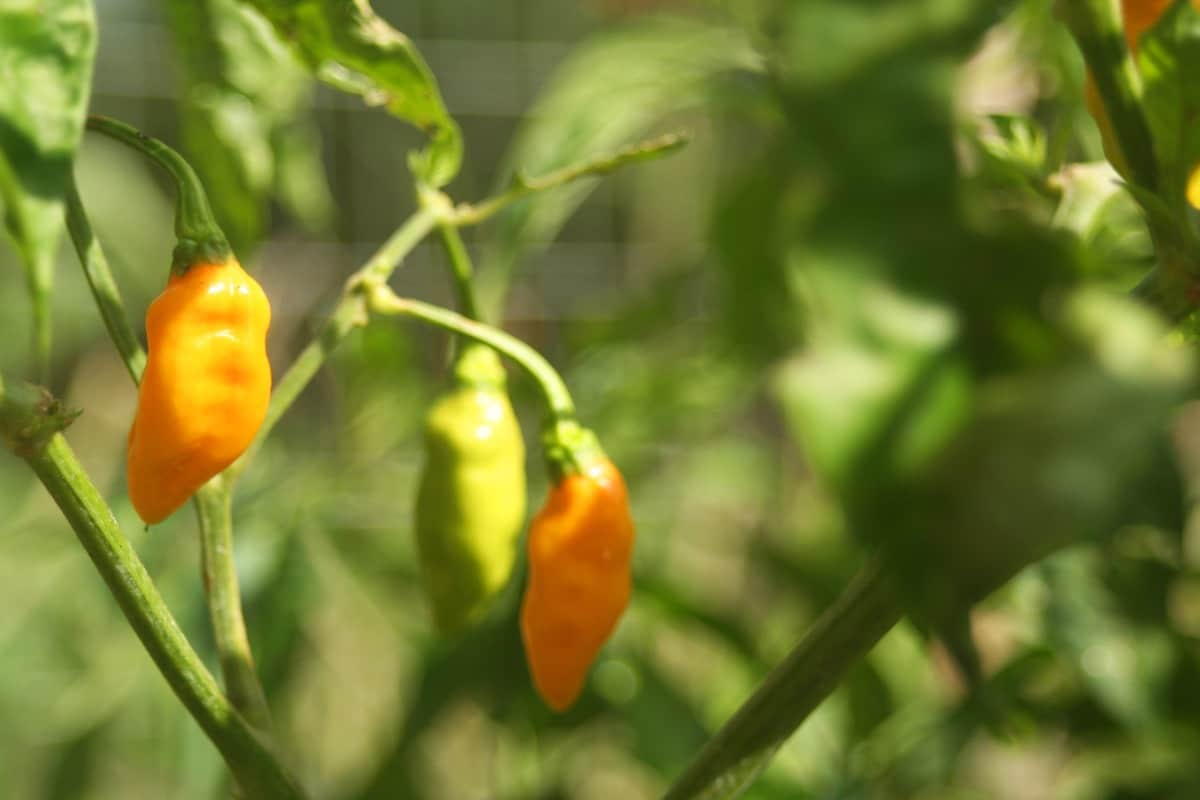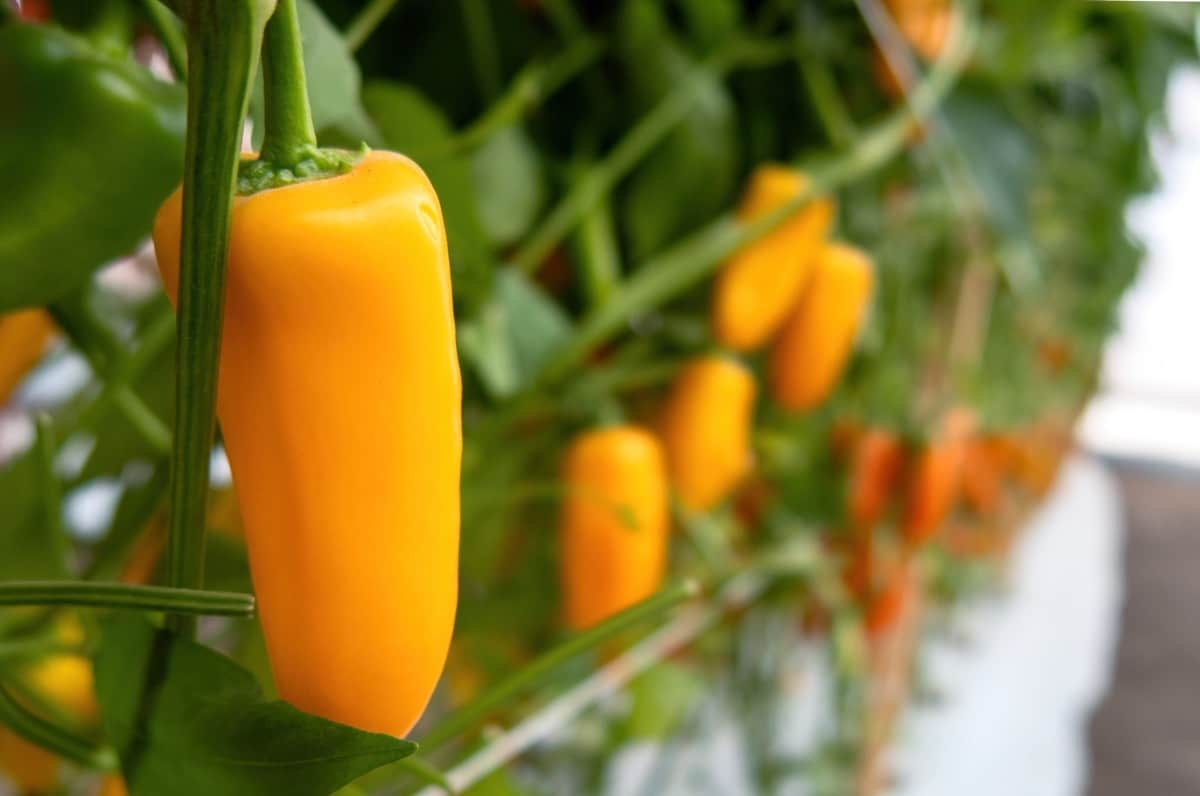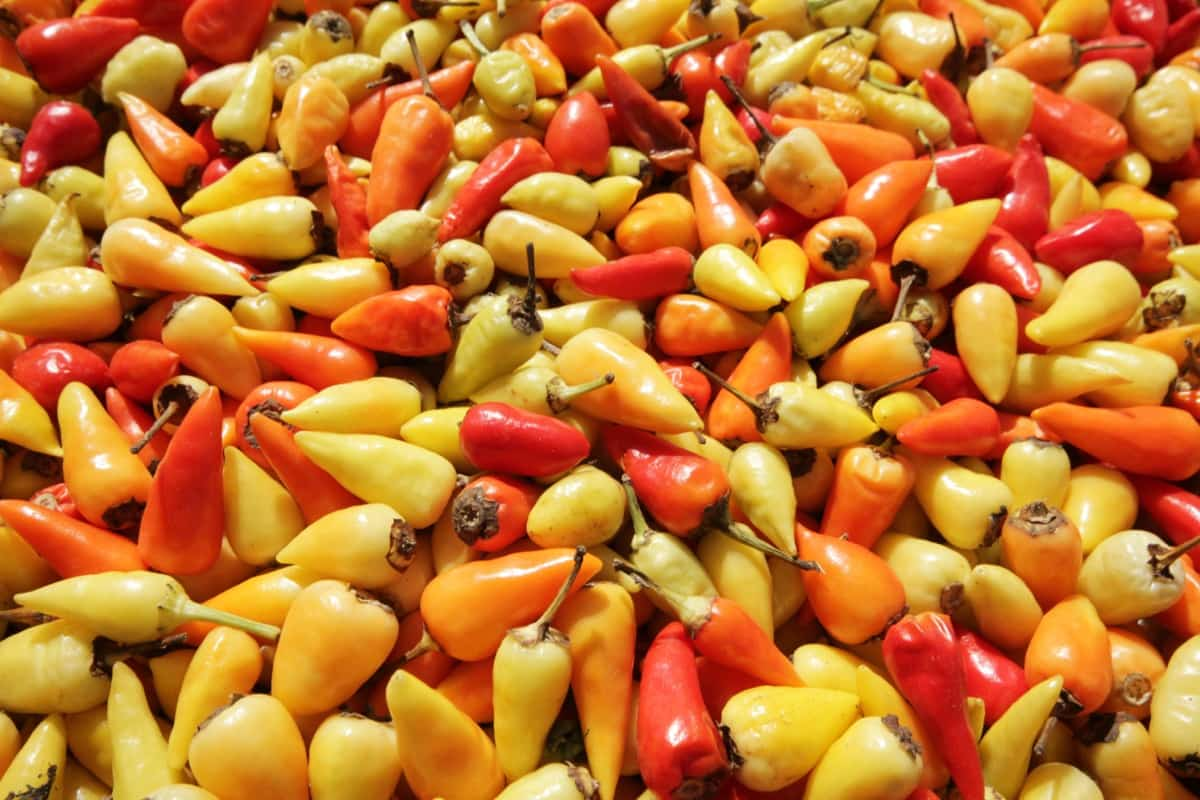Growing Habanero Peppers from seed is a rewarding and fun experience. You can quickly grow your delicious Habanero Pepper plants with the right soil, sunlight, watering schedule, and fertilizer. With patience and care, you will soon have a bountiful crop of flavorful Peppers. With the right techniques, you can be proud of the harvest of your homegrown spicy fruits in no time.

There are many Habanero Peppers, all varying in color, shape, and size. The most common type of Habanero Pepper is the orange Habanero, which most people think of when they think of this type of Pepper. However, there are also red, white, and black Habanero Peppers. Each type of Habanero Pepper has its unique flavor profile, so choosing the right one for your needs is important.
How to Grow Habanero Peppers from Seed
Types of Habanero Peppers
Caribbean Red
The Caribbean Red Habanero is the most popular Habanero Pepper. This chili Pepper is bright red and has a very spicy, fruity flavor. It is often used in hot sauces and salsas. They are characterized by their bright red color and their fiery hot flavor. If you’re looking for a Pepper that packs a punch, the Caribbean red Habanero is for you.
Chocolate Habanero
Chocolate Habanero Peppers are one of the most popular Habanero Peppers. They are characterized by their chocolate brown color and their slightly sweet flavor. The chocolate Habanero is one of the milder varieties of Habanero Peppers. It is often used in sauces and salsas because of its unique flavor.
Habanero Orange
Habanero Orange is one of the many types of Habanero Peppers. As its name suggests, it is characterized by its orange color. It is one of the sweeter Habanero Pepper varieties, with a fruity flavor and moderate heat.
In case you missed it: How to Grow Serrano Peppers from Seed: A Step-by-Step Planting Guide for Beginners

Red Savina
Red Savina Habanero Peppers are the most popular Habanero Peppers. Red Savina Peppers are distinguished by their deep red color and slightly sweeter flavor. The Red Savina is a variety of Habanero Pepper that was once the hottest chili Pepper in the world. The Peppers are small, only 2-3 inches long, and have a deep red color.
Container Size Suitable for Growing Habanero Peppers
When growing Habanero Peppers, choosing a container size that will allow the plant to grow and produce fruit is important. The best option is a 5-gallon container, providing plenty of space for the roots to grow and the plant to produce fruit. If you are growing multiple plants, you may need to increase the size of your containers.
Propagating Habanero Peppers from Seed
If you want to grow your Habanero Peppers, it’s easy to do so from seed. All you need is a little patience and some basic gardening supplies. Start by soaking your Habanero Pepper seeds in water for 24 hours. This will help them germinate more easily. Fill the tray or pot with a well-draining soil mix. Wet the soil slightly before planting the seeds. Sow the seeds about ½ inch deep in the soil, spacing them about 2 inches apart. Press them into the soil, but don’t compact them too much. Water the seeds gently and place the tray or pot in a warm, sunny spot.
The ideal germination temperature for Habanero Pepper seeds is between 26 to 30°C, and it may take two weeks for the seeds to germinate. If starting your Habanero Pepper plants indoors, you must provide bottom heat using a heat mat or grow light. Once the seedlings emerge, they should be transplanted into individual pots and moved to a sunny location. Your Habanero Pepper plants can be moved outdoors when the weather warms up in late spring or early summer.
Transplanting Habanero Pepper Seedlings
When transplanting, handle the seedlings carefully so as not to damage the fragile roots. Dig a hole larger than the container your seedling is in, then gently remove it and place it in the hole. Fill any spaces around the plant with soil, then water the well to help settle the roots. After transplanting, keep an eye on your plants and ensure they get enough water and sunlight. If they start to wilt or look unhealthy, try adjusting their environment until they start looking better. With a little care, your Habanero Pepper plants will continue to grow and produce Peppers for you to enjoy.
In case you missed it: How to Grow Tabasco Peppers from Seeds: At Home, In Pots, Raised Beds, Terraces, and Backyard

Habanero Pepper Plant Care
Climate Suitable for Growing Habanero Peppers from Seed
You’ll need to provide plenty of light to ensure your Habanero Peppers have the best chance of germination and growth. An ideal spot for growing Habaneros is near a south- or west-facing window. If you don’t have a suitable location in your home, you can use grow lights. To successfully grow Habanero Peppers from seed, you must provide them with ample light.
Habanero Peppers require at least six hours of direct sunlight daily, so a south-facing window is ideal. You can supplement with artificial lighting if you do not have a south-facing window. Place your seedlings under a grow light for 12 hours daily. Habanero Peppers require direct sunlight to grow successfully from seed. If you live in a hot climate, provide some afternoon shade to prevent the Peppers from getting too much sun and drying out.
Soil Requirement for Growing Habanero Peppers from Seed
It is generally recommended that Habanero Peppers be grown in soil with a pH between 6.0 and 7.0. You have a few options when choosing the best soil for growing Habanero Peppers from seed. One option is to purchase pre-mixed potting soil designed explicitly for Pepper plants. These mixes are usually well-balanced and provide all the nutrients your Pepper plant needs to thrive.
Another option is to make your potting mix using peat moss, perlite, and vermiculite. This potting mix must be supplemented with additional nutrients, such as compost or manure, throughout the growing season. Whichever route you choose, make sure that you start with high-quality soil that is free of weeds and other debris.
Water Requirement for Growing Habanero Peppers from Seed
If you plan on growing Habanero Peppers from seed, you must ensure you keep them well-watered. These Peppers are native to tropical and subtropical regions and are used to hot, humid weather. To recreate these conditions, you’ll need to water your plants regularly and mist them with a spray bottle if the air is too dry. During germination, it’s essential to keep the soil moist but not soggy.
In case you missed it: How to Grow Banana Peppers from Seed in Pots or Ground

You can do this by watering lightly and often, ensuring the top inch or so of soil is always damp. Once the seedlings have emerged, you can cut back on watering slightly, but make sure not to let the soil dry out completely. As the Peppers start to mature, they’ll need even more water. During this time, it’s essential to pay attention to the weather and consider any rainfall that might occur. Adjust your watering schedule accordingly so that the plants can always access moisture.
Fertilizer Requirement for Growing Habanero Peppers from Seed
If you plan on growing Habanero Peppers from seed, it’s essential to know that they have specific fertilizer requirements. Habanero Peppers are heavy feeders that require much nitrogen and potassium to grow well. A good fertilization schedule for Habanero Peppers would be to apply a high-nitrogen fertilizer every 2-3 weeks during the growing season.
In addition to regular fertilization, it’s important to ensure your plants get enough water. For best results, use a balanced fertilizer with an N-P-K ratio of 10-10-10. Habanero Peppers need about 1 inch of water per week, so keep an eye on the soil moisture levels and water accordingly. You can also add some organic matter to the soil to help provide the plants with additional nutrients.
Pruning Habanero Peppers
By pruning, you can encourage plant growth, prevent disease, and improve the yield and quality of your Peppers. Pruning your Habanero Pepper plants is important to keep them healthy and productive. Removing dead or dying leaves and stems allows the plant to focus its energy on new growth. Pruning also helps to prevent disease by removing potential entry points for pests and pathogens.
In case you missed it: How to Grow Ghost Peppers from Seed: At Home, in Pots, Raised Beds, Terrace, and Backyard

Cut off dead or dying leaves and stems to prune your Habanero Pepper plants. Then, clip any branches that are crossing or rubbing against each other. Finally, trim back any long or leggy branches to encourage fuller growth. When pruning your plants, use sharp, clean shears or a knife. This will help to prevent the spread of disease. Also, dispose of any cuttings in the trash; do not compost them.
Habanero Pepper Plant Care in Winter
The Habanero Pepper plant care in winter is relatively simple compared to other plants. They do not require much water and can tolerate some frost. However, if you live in very cold winters, it is best to protect your plants from the cold weather by covering them with a frost blanket or burlap. Pepper plants are also susceptible to fungal diseases, so watch for any signs of disease and treat them accordingly.
Staking Habanero Peppers
Staking Habanero Peppers is a simple process that will yield a higher yield. Stacking the Pepper plant allows it to grow taller and produce more Peppers. The first step is to select a stake at least 2 feet tall. You can use a bamboo stake or a wooden stake. Be sure to choose a strong stake to support the weight of the plant and the Peppers.
Next, drive the stake into the ground next to the Pepper plant. Ensure the stake is driven into the ground at least 8 inches to be stable. Once the stake is in place, tie the Pepper plant stem to the stake using twine or garden wire. Be sure to leave some slack in the tie so the plant can move slightly in the wind. This will help to prevent breakage.
Pests and Diseases of Habanero Peppers and Their Control
The Habanero Pepper is a popular choice for those who enjoy spicy food. Habanero Peppers are susceptible to several pests. One of the most common pests of Habanero Peppers is tobacco budworm. These caterpillars are particularly fond of eating the leaves of the Pepper plant. If left unchecked, they can quickly defoliate a plant. Caterpillars can be controlled using Bacillus thuringiensis, an organic bacterium that is deadly to caterpillars but harmless to humans and other animals.
Another common pest of Habanero Pepper is the aphid. Aphids are small insects that feed on plant sap. They can cause damage to the plant by sucking out vital nutrients. Aphids can be controlled with the use of insecticidal soap or horticultural oil. Spider mites are another type of pest that can infest Habanero plants. These tiny spider-like creatures feed on plant tissue and can cause the Pepper plant’s leaves to turn yellow and stunted. Spider mites can be controlled using predatory mites or insecticidal soap.
In case you missed it: Best and Worst Companion Plants for Peppers – A Full Guide

If you plan to grow Habanero Peppers, you must be aware of the diseases affecting them and the steps you can take to control them. The most common diseases of Habanero Peppers are fungal diseases, such as powdery mildew and anthracnose. These diseases can be controlled with the use of fungicides. Another disease that can affect Habanero plants is root-knot nematodes. These parasitic worms attack the roots of plants and cause them to become deformed. Root-knot nematodes can be controlled with the use of insecticides or nematicides.
Harvesting Habanero Peppers
Harvesting Habanero Peppers is a simple process that can be done by hand or using gardening tools. The Habanero Pepper plant will produce Peppers ready to harvest when they are bright red and mature. To harvest, cut the stem of the Pepper plant at the base of the Pepper using a sharp knife. Be sure to wear gloves when handling Habanero Peppers, as they irritate the skin.
Conclusion
Growing Habanero Peppers from seed is an exciting and fun way to start your garden. You can have a thriving Pepper plant with the right soil, water, and location. Just remember that, like all plants, Habanero Peppers need patience and care if they are going to thrive.
- Growing Red Currants at Home for Beginners
- Gardening Techniques in Planting Vegetables
- Where to Place Indoor Plants in Your Home
- How to Grow Tomatoes Organically at Home: A Comprehensive Guide
- Organic Gardening on a Budget: Low-Cost Methods and Materials
- Gongura Seed Germination and Planting Methods
- Cabbage Seed Germination and Selection
- Broccoli Seed Germination and Selection
- Asparagus Seed Germination and Variety Selection
- Seasonal Flower Gardening: Best Practices for Spring, Summer, Fall, and Winter
- How to Grow Hibiscus from Flower
- Plantation Ideas for Home Decoration: A Beginners Guide
- Flower Garden Designs and Layouts for Beginners
- Planting and Spacing Techniques in Papaya: A Beginner’s Guide
- Growing Gold: Essential Techniques for Planting Pineapples
- How to Make Kalanchoe Plant Bushy: Home Remedies and Solutions
- 11 Reasons Why Your Gardenia is Not Blooming: Home Remedies and Solutions
- Eco Elegance: The Guide to Designing a Drought-Tolerant Landscape
- Gardening on a Slope: Strategies for Hillside Landscaping
- Nourish and Flourish: Top Organic Mulches for Thriving House Plants
- Everything You Want to Know about Indian Mogra Flower: Discover Uses and Growing
- Green Thumb Success: Expert Tips for Cultivating Greenhouse Pumpkins All Year Round
- Maximize Growth & Flavor: The Ultimate Guide to Companion Planting in Herb Gardens
- How to Control Rhododendron Problems Naturally: Home Remedies and Organic Ways to Fix Them
- Natural Magic: The Remarkable Benefits of Cinnamon for Plants
- Best Steps to Revive Dying Tulip with Natural and Organic Treatment
- 10 Reasons Why Your Angel Trumpet is Not Blooming: Remedies and Treatment
- How to Fix Periwinkle Leaf and Flower-Related Problems: Natural Remedies and Solutions
- How to Fix Zinnias Leaf and Flower Problems: Discover Natural and Home Remedies
- Organic Steps to Induce Lemon Tree Flowers: A Comprehensive Guide
- Bloom Booster: Crafting the Perfect Homemade Bougainvillea Fertilizer
- Optimizing Growth: A Guide to Applying NPK Fertilizer for Potted Plants
- 10 Best Homemade Fertilizers for Rubber Plant: DIY Recipes and Application Method
- How to Boost Female Pumpkin Flowers: Effective Steps for More Flowers and High Yields
- Transform Your Indoor Garden: Top Benefits of Pink Salt for Houseplants
- 10 Best Homemade Fertilizers for Peacock Plants (Calathea): Easy DIY Guide